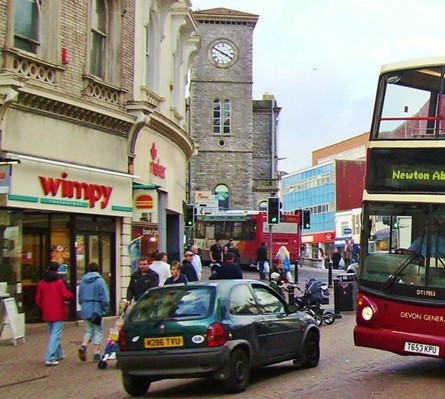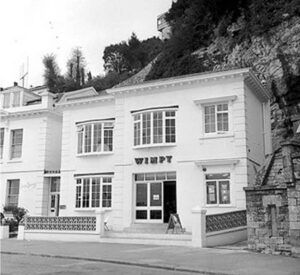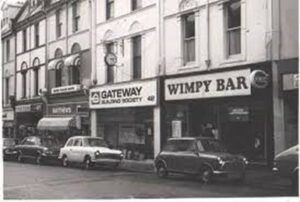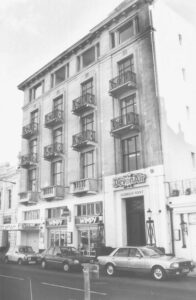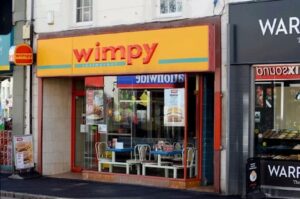In a time before Burger King; predating even McDonald’s; there was Wimpy.
During the mid-1950s rock and roll dominated the British musical scene, either by American performers or re-creations of musical forms originating in the United States. But quickly British adaptations appeared, in jazz, skiffle, folk, and rock and roll. Eventually we would return those musical forms to the States greatly refashioned.
Alongside this bringing in and remodelling of music from the United States, came other American cultural forms. These would be enthusiastically absorbed, particularly by the young, and adapted for a colder and older place.
Moreover. amongst the aspirational lifestyles that we viewed in cinemas were unfamiliar types of food and drink, alongside new ways and places in which to consume them. The post-War economic boom had allowed Americans to buy more of everything and the culture of consumerism that took hold caused many to work outside the home. Eating out, previously considered a luxury, became common with many demanding rapid service and inexpensive food. A so-called ‘fast-food industry’ was then created.
t would only be a matter of time before this development made its way across the Atlantic. The British, of course, were not strangers to quick and inexpensive hot food that could be collected from shops. The development of trawler fishing in the mid-nineteenth century had even created the national dish, the first recorded fish and chip shops operating in the 1860s. And, despite the modern pasty’s strong association with Cornwall, that fast-food seems to have its origins at least as far back as the thirteenth century.
But what now came to Britain wasn’t just a novel type of food. It was a whole, so-modern, experience, exemplifying the end of austerity; brightly hued progress in a bun.
In a 1955 article entitled ‘Europe’s culture falls to hot dog’, The Washington Post wrote of the growing American influence on British culture. The focus of the piece was the opening of a ‘Wimpy’s Hamburger Parlor’ in London and it described,
“Food served at the table within ten minutes of ordering and with atomic age efficiency. No cutlery needed or given. Drinks served in a bottle with a straw. Condiments in pre-packaged single serving packets.”
The interloper was Wimpy, the burger-joint pioneer, giving diners their first exposure to American-style fare.
Paignton
It all began in 1934 in Bloomington, Indiana, when Edward Gold launched Wimpy Grills, the name being inspired by the Popeye cartoon character. By 1947 the chain’s 26 locations were selling eight million hamburgers annually.
But it wasn’t in the United States that Wimpy became so influential. In 1954, Edward sold a licence to J Lyons & Co to use the Wimpy name in Britain. That year the first ‘Wimpy Bar’ was established at the Lyons Corner House in London’s Coventry Street. Starting as a discrete novelty fast-food section within the traditional Corner House restaurants, its success soon led to the establishment of separate Wimpy restaurants serving only hamburger-based meals.
Y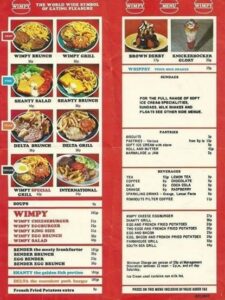 et, while Wimpy presented itself as an exciting and authentic import from an exotic and wealthier other place, here was not an exact copy of the Stateside experience. As with music, the Wimpys mutated to serve a very British approximation of what hamburgers should be. We further subverted the American dream with ham or sardine rolls called torpedoes and a cold frankfurter with pickled cucumber sandwiches called Freddies.
et, while Wimpy presented itself as an exciting and authentic import from an exotic and wealthier other place, here was not an exact copy of the Stateside experience. As with music, the Wimpys mutated to serve a very British approximation of what hamburgers should be. We further subverted the American dream with ham or sardine rolls called torpedoes and a cold frankfurter with pickled cucumber sandwiches called Freddies.
Wimpy soon came to dominate Britain’s fast-food with, at its peak, over 500 restaurants in the UK. It had a presence on almost all high streets with around 75 million Wimpy meals being consumed annually. By 1970, the Wimpy brand was global with more than a thousand outlets in 23 countries around the world.
Torquay and Paignton, needless to say, welcomed yet another contribution to the mosaic of outside cultural influences. And locals still recall their childhood experience of Wimpys, often due to the hosting of innumerable birthday parties.
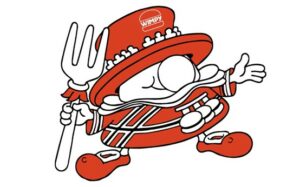 Yet back in the States, Wimpy only had seven locations at the time of Edward Gold’s death in 1977. The chain then disappeared within the United States because no one purchased the rights and trademark to the Wimpy name from Edward’s estate.
Yet back in the States, Wimpy only had seven locations at the time of Edward Gold’s death in 1977. The chain then disappeared within the United States because no one purchased the rights and trademark to the Wimpy name from Edward’s estate.
Inevitably, however, Wimpys success would attract envious eyes. The most serious competition came from a rival that had followed the Wimpy example, taking much the same route across the Atlantic. This was, of course, McDonald’s, founded in 1940 in San Bernardino, California. On 13 November 1974 McDonald’s opened its first restaurant in Woolwich, south-east London.
Torquay
Crucially, McDonald’s sold their food over the counter. Wimpy, which employed traditional table service, fought back by partly converting to counter service and has alternated between being a table-service establishment to counter-service ever since.
Yet, despite their head-start in the burger business, Wimpy began to lose ground and the number of its restaurants gradually decreased.
In 1977 the company was sold to United Biscuits, and then to Grand Metropolitan in 1989. The new owner then began to phase out the Wimpy Bar in the United Kingdom, rebranding many of them as Burger King, a chain they also held. The rationale was that Burger King had the greater brand recognition amongst consumers and was seen to be more able to rival McDonald’s. Following various buyouts, Wimpy was subsequently sold to Famous Brands in 2007.
Newton Abbot
By the beginning of the twenty-first century, most high streets, including those in Paignton and Torquay had lost their Wimpys. Those remaining were franchises usually to be found in cheaper locations, catering to pensioners and other consumers on a fixed income.
Today there are around 66 Wimpys still out there. In contrast, McDonald’s has more than 1,270 restaurants while Burger King has 533 outlets.
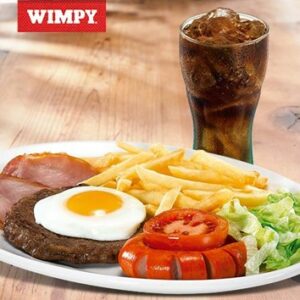 Across our Bay we’re left with indistinct memories of the whole faux Anglo-American Wimpy experience. Many of us still have pleasing recollections of primary coloured Formica, fluorescent lighting, and of unique culinary offerings now lost. Of the brand’s thick milkshake, the Whippsy; the Brown Derby, a doughnut with ice cream and fudge flakes; and that New York-style indulgence, the Knickerbocker Glory, served in a tall conical glass and eaten with a distinctive long spoon.
Across our Bay we’re left with indistinct memories of the whole faux Anglo-American Wimpy experience. Many of us still have pleasing recollections of primary coloured Formica, fluorescent lighting, and of unique culinary offerings now lost. Of the brand’s thick milkshake, the Whippsy; the Brown Derby, a doughnut with ice cream and fudge flakes; and that New York-style indulgence, the Knickerbocker Glory, served in a tall conical glass and eaten with a distinctive long spoon.
But perhaps nothing exemplifies that lost experience more than the idiosyncratic Wimpy Bender, a spicy smoked sausage ingeniously curled around half a tomato.
Childhoods are made of such things.
‘Torquay: A Social History’ by local author Kevin Dixon is available for £10 from Artizan Gallery, Lucius Street, Torquay, or:
https://www.art-hub.co.uk/product-page/torquay-a-social-history-by-kevin-dixon


